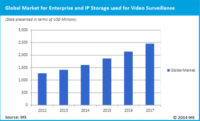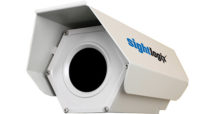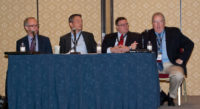At the end of 2016, two random acts of violence shocked New Orleans and spurred a $40 million investment in public safety infrastructure and improvements, leading to the creation of the New Orleans Real-Time Crime Center (RTCC) – a 24/7 surveillance monitoring center under the Office of Homeland Security and Emergency Preparedness. Now, barely a year past its first shift in November 2017, the RTCC has helped police conserve more than 2,000 man-hours and improve crime clearance rates across the city.
Like many police departments across the U.S., the NOPD was struggling to attract and retain officers, so there was a real need for an artificial force multiplier, says Ross Bourgeois, RTCC Administrator. Therefore, the RTCC was built to increase efficiency, not to directly detect and solve crimes, and since the RTCC is run by a civilian staff, that meant the technology used needed to be user-friendly, intuitive and automated.
When investigating solutions that would fit New Orleans, Bourgeois and RTCC IT manager George Barlow Brown traveled to cities with similar footprints and infrastructure – St. Louis, Chicago and Detroit – to review what worked well and what pitfalls they should avoid.
“I can’t ask my staff to have the same knowledge of the city as a five-year police officer patrolling a district,” Brown says. “A technician is reviewing an incident on camera in the 2nd District, and 10 minutes later there’s an alert in the 6th District. We wanted the option to have cameras turn on automatically, to present a map for our technicians, to have all this automation available at their fingertips.”
Through the Citywide Public Safety Project, more than 200 additional panoramic, fixed or pan/tilt/zoom (PTZ) Axis Communications cameras were installed in key areas around the city (bringing the total number of city-owned cameras in the system nearer to 400), as well as strategically placed radar systems. The system uses Motorola’s CommandCentral Aware software to integrate geolocation data from the city’s 911 dispatch center with GPS coordinates of cameras managed by Genetec Security Center and Stratocast video management systems.
Through the SafeCam Platinum program – which enables local businesses and residents to connect the RTCC with their live public-facing camera feeds to investigate incidents – gives the city access to a further 6,000 camera feeds.
“There’s a lot of attention on the French Quarter as a tourism center for the city,” Brown says. “We absolutely have Bourbon Street covered with 90-plus camera views, but we have plenty of people in the French Quarter – both residents and business-owners – who want to see the French Quarter continue to be a very safe place.”
The remote aspect of this program greatly improves residents’ and businesses’ willingness to participate and even add cameras, Brown says. Previously, if a robbery happened outside a restaurant, police would have needed to come inside, ask for a manager and request access to camera footage, which could easily shift diners’ conversations to the crime instead of how they’re enjoying their food. This led to businesses taking down their exterior cameras to avoid disruptions. However, with the new system, police no longer need to go inside to access camera footage after an incident, and restaurants, businesses and homeowners are putting cameras back up.
Having access to the footage also helps verify events to help police respond appropriately. “If a home alarm system goes off and a neighbor has video of no one entering or exiting the home, that knowledge can help reduce unknown variables and deescalate the police response. That goes a long way towards officer safety,” says Brown.
The system also goes a long way towards saving officers’ time. Even for a simple matter like responding to a traffic crash, police officers can save a little time interviewing the drivers and witnesses by reviewing camera footage instead. Officers also save more than an hour every time they can access camera footage instantly and remotely instead of collecting it from a homeowner, driving it to the Central Evidence and Property Section office and entering it into the system.
“We’re giving them man-hours back, and it’s up to the police department to use them wisely,” Bourgeois says.
Brown adds that shaving off a little time here and there enables officers to patrol neighborhoods more, which increases visibility and citizens’ buy-in, resulting in more and better 911 calls, increasing solve rates and deterring crime.
NOPD Superintendent Michael Harrison credited instant access to video with aiding in the improved clearance rates in the 8th District, which encompasses the French Quarter and Central Business District; police solved all but one of 10 non-fatal shootings reported in 2018, and raised the clearance rate for armed robberies in the District from 40 percent in 2017 to 51 percent in 2018 (as of early December).
Through November 2018, the RTCC has processed 2,300 requests for assistance from various public agencies, and in 70 percent of cases, the center was able to provide footage.
By intentionally placing the RTCC under the Office of Homeland Security and Emergency Preparedness instead of inside the NOPD, more use cases are open to the city. Currently, the RTCC is partnering with the Sewage and Water Board to install cameras and flood sensors near frequent flood zones. When an underpass starts to flood, for example, the alert is called up in the RTCC like a call for service, and technicians are able to verify the flooding and measure how deep the water is, which helps city officials make faster decisions about what to tell citizens and whether or not the area needs to be blocked off to traffic.
The RTCC is also partnering with the Sanitation Department to combat illegal dumping as part of a wider “Clean Up NOLA” initiative. The center is using radar technology to monitor abandoned streets or areas for frequent dumping of trash, old furniture or other items.
“Illegal dumping is a social crime that no one really dials 911 about, but by using radar, we can help sanitation with their public awareness campaign, capture some better footage, get license plate information and share that with code enforcement,” Brown says.
Moving forward, the RTCC can be used by the fire department to investigate fires or by EMT services to detect the least trafficked routes to hospitals.






